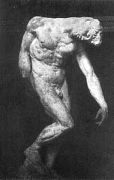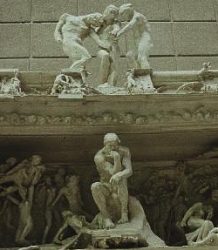|
 As
a variation of 'Adam' with a less distorted attitude, Rodin executed 'The
Shades': a triple representation of the same figure, mounted at the top of
the 'Gates of Hell'. With their left hands they show down and direct the
eyes of the viewer to 'The Thinker', who is
located immediately beneath 'The Shades'. This threefold repetition
of gesture, focussing in the same point, underlines the As
a variation of 'Adam' with a less distorted attitude, Rodin executed 'The
Shades': a triple representation of the same figure, mounted at the top of
the 'Gates of Hell'. With their left hands they show down and direct the
eyes of the viewer to 'The Thinker', who is
located immediately beneath 'The Shades'. This threefold repetition
of gesture, focussing in the same point, underlines the inevitability of fate, echoeing mythological tales like that of the Greek
Moirae (Clotho, Lachesis and Atropos). Lampert attributes this repitition
to Rodin's intention to reach a more haunting effect and refers to Leo
Steinberg, who interpreted Rodin's obsession with repeating forms and
patterns as a foreboding of modern painting. Commenting on the 'Three
Faunesses', Steinberg wrote:
inevitability of fate, echoeing mythological tales like that of the Greek
Moirae (Clotho, Lachesis and Atropos). Lampert attributes this repitition
to Rodin's intention to reach a more haunting effect and refers to Leo
Steinberg, who interpreted Rodin's obsession with repeating forms and
patterns as a foreboding of modern painting. Commenting on the 'Three
Faunesses', Steinberg wrote:
"By assembling three casts of her, Rodin's wins for
himself the painter's advantage. The margins become engaged intervalls, so
that the repeat of this one irregular body yields infinite rhythmic
amplifications."
In her essay 'Rodin's Gates of Hell: Sculptural illustration of
Dante's Divine Comedy' Aida Audeh, however, points to Canto XVI as the
literary source of 'The Shades' and their threefold appearance on top of
'The Gates'. In this part of the poem, Dante meets the souls of three
Florentine men condemned for the act of sodomy. The punished figures are
exposed to a rain of fire and in incessant motion while trying to avoid
the scorching heat.
In 1887 Cosmo Monkhouse interpreted 'The Three Shades'
as a personification of the first three lines of the inscription over the
door of Dante's Hell:
"The Gate of Despair ... The lintel is surmonted by a
group of three nude, emaciated, and miserable figures, the plastic
translation of the first three lines of the well-known inscription over
the door of Dante's hell:
'Per me si va nella cittą dolente,
Per me si va nell' eterno dolore,
Per me si va tra la perduta gente'
... By what sad harmony of unlovely lines the artist has quelled our
natural aversion to such a sight, by what subtle touches he has
transformed these ghastly images into a voice which stays our feet,
possibly M. Rodin himself could scarcely tell but it is something more
than a tour de force, for it shows the operation of the born
artistic faculty which cannot conceive except in accordance with the great
laws of fitness and harmony. The idea is not a pleasant one, but is
conveyed with power, and the group is 'ideal' in the plainest sense of the
word."
|
 As
a variation of 'Adam' with a less distorted attitude, Rodin executed 'The
Shades': a triple representation of the same figure, mounted at the top of
the 'Gates of Hell'. With their left hands they show down and direct the
eyes of the viewer to
As
a variation of 'Adam' with a less distorted attitude, Rodin executed 'The
Shades': a triple representation of the same figure, mounted at the top of
the 'Gates of Hell'. With their left hands they show down and direct the
eyes of the viewer to inevitability of fate, echoeing mythological tales like that of the Greek
Moirae (Clotho, Lachesis and Atropos). Lampert attributes this repitition
to Rodin's intention to reach a more haunting effect and refers to Leo
Steinberg, who interpreted Rodin's obsession with repeating forms and
patterns as a foreboding of modern painting. Commenting on the 'Three
Faunesses', Steinberg wrote:
inevitability of fate, echoeing mythological tales like that of the Greek
Moirae (Clotho, Lachesis and Atropos). Lampert attributes this repitition
to Rodin's intention to reach a more haunting effect and refers to Leo
Steinberg, who interpreted Rodin's obsession with repeating forms and
patterns as a foreboding of modern painting. Commenting on the 'Three
Faunesses', Steinberg wrote: